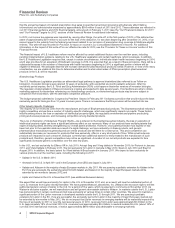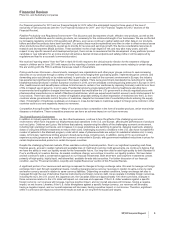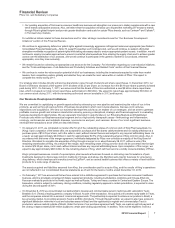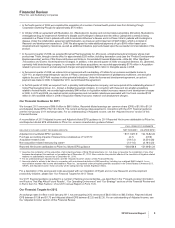Pfizer 2010 Annual Report Download - page 16
Download and view the complete annual report
Please find page 16 of the 2010 Pfizer annual report below. You can navigate through the pages in the report by either clicking on the pages listed below, or by using the keyword search tool below to find specific information within the annual report.
Financial Review
Pfizer Inc. and Subsidiary Companies
•For indefinite-lived intangible assets, such as Brands and IPR&D assets, each year and whenever impairment indicators are present,
we determine the fair value of the asset and record an impairment loss for the excess of book value over fair value, if any. In addition, in
all cases of an impairment review other than for IPR&D assets, we re-evaluate whether continuing to characterize the asset as
indefinite-lived is appropriate.
When we are required to determine the fair value of intangible assets other than goodwill, we use an income approach, specifically
the multi-period excess earnings method, also known as the discounted cash flow method. We start with a forecast of all the
expected net cash flows associated with the asset, which includes the application of a terminal value for indefinite-lived assets, and
then we apply an asset-specific discount rate to arrive at a net present value amount. Some of the more significant estimates and
assumptions inherent in this approach include: the amount and timing of the projected net cash flows, which includes the expected
impact of competitive, legal and/or regulatory forces on the projections and the impact of technological risk associated with
in-process research and development assets as well as the selection of a long-term growth rate; the discount rate, which seeks to
reflect the various risks inherent in the projected cash flows; and the tax rate, which seeks to incorporate the geographic diversity of
the projected cash flows.
Future Impairment Risks
While all intangible assets other than goodwill can confront events and circumstances that can lead to impairment, in general,
intangible assets other than goodwill that are most at risk of impairment include in-process research and development assets ($3.4
billion as of December 31, 2010) and newly acquired or recently impaired indefinite-lived assets ($7.4 billion as of December 31,
2010). In-process research and development assets are high-risk assets, as research and development is an inherently risky
activity. Newly acquired and recently impaired indefinite-lived assets are more vulnerable to impairment as the assets are recorded
at fair value and are then subsequently measured at the lower of fair value or carrying value at the end of each reporting period. As
such, immediately after acquisition or impairment, even small declines in the outlook for these products can negatively impact our
ability to recover the carrying value and can result in an impairment loss.
One of our indefinite-lived Biopharmaceutical assets, Xanax, has a fair value that is only marginally higher than its $1.4 billion
carrying value and is therefore at risk for future impairment. Any negative change in the undiscounted cash flows, discount rate and/
or tax rate could result in an impairment charge. Xanax, which was launched in the mid 1980’s and acquired in 2003, must continue
to remain competitive against its generic challengers or the associated asset may become impaired. We will continue to closely
monitor this asset.
Goodwill
As a result of our goodwill impairment review work, described in detail below, none of our goodwill is impaired as of December 31,
2010, and we do not believe the risk of impairment is significant at this time.
Accounting Policy and Specific Procedures
Annually and whenever impairment indicators are present, we calculate the fair value of each reporting unit and compare the fair
value to its book value. If the carrying amount is found to be greater, we then determine the implied fair value of goodwill by
subtracting the fair value of all the identifiable net assets other than goodwill from the fair value of the reporting unit and record an
impairment loss for the excess, if any, of book value of goodwill over the implied fair value.
In determining the fair value of a reporting unit, as appropriate for the individual reporting unit, we may use the market approach, the
income approach or a weighted-average combination of both approaches.
•The market approach is a historical approach to estimating fair value and relies primarily on external information. Within the market
approach are two methods that we may use:
OGuideline public company method—this method employs market multiples derived from market prices of stocks of companies that
are engaged in the same or similar lines of business and that are actively traded on a free and open market and the application of
the identified multiples to the corresponding measure of our reporting unit’s financial performance.
OGuideline transaction method—this method relies on pricing multiples derived from transactions of significant interests in companies
engaged in the same or similar lines of business and the application of the identified multiples to the corresponding measure of our
reporting unit’s financial performance.
The market approach is only appropriate when the available external information is robust and deemed to be a reliable proxy for
the specific reporting unit being valued; however, these assessments may prove to be incomplete or inaccurate. Some of the
more significant estimates and assumptions inherent in this approach include: the selection of appropriate guideline companies
and transactions and the determination of applicable premiums and discounts based on any differences in ownership
percentages, ownership rights, business ownership forms or marketability between the reporting unit and the guideline companies
and transactions.
•The income approach is a forward-looking approach to estimating fair value and relies primarily on internal forecasts. Within the income
approach, the method that we use is the discounted cash flow method. We start with a forecast of all the expected net cash flows
associated with the reporting unit, which includes the application of a terminal value, and then we apply a reporting unit-specific
discount rate to arrive at a net present value amount. Some of the more significant estimates and assumptions inherent in this approach
include: the amount and timing of the projected net cash flows, which includes the expected impact of technological risk and
competitive, legal and/or regulatory forces on the projections as well as the selection of a long-term growth rate; the discount rate,
which seeks to reflect the various risks inherent in the projected cash flows; and the tax rate, which seeks to incorporate the geographic
diversity of the projected cash flows.
14 2010 Financial Report
























